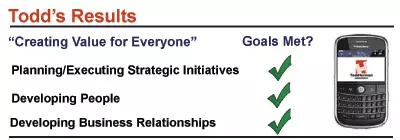 |
| Learn the purpose behind the chart and the Blackberry. |
Ah-Ha! Moment – In October, I began to more fully live out the "Situational Leadership" model from Leadership and the One Minute Manager. I did this through "One Minute Goal Setting" for two projects with the staff member mentioned last month. These two projects could not have been more different:
- The first was a small, relatively well-defined project, where she and I could quickly agree on the goals, timelines, deliverables, and other parameters of the assignment.
- The second was a new, very big, and highly creative strategic project we called "Relationship Management."
We had talked about aspects of "Relationship Management" for over a year, and knew its success would require drawing together many separate elements into a coherent whole. The problem – neither she nor I knew how this would look. Accordingly, while this project was in my associate's areas of strength, and while we would normally assess her Competence and Commitment as "High," this project's attributes – its size, fuzziness, newness, and complexity – caused our mutual assessment for her to be:
- Low Competence – Because neither she nor I could describe the DELIVERABLES of this project, she did not know HOW to proceed.
- Low Commitment – Because neither she nor I could initially envision HOW this project could get done, her motivation was low.
When someone begins a new project, the "Situational Leadership" model presumes the person needs a "Directing" leadership style, reflecting High Commitment and Low Competence – however, we found this to be true only for the smaller, well-defined project. For the "Relationship Management" project, my associate and I agreed "Coaching" was the appropriate leadership style because of this project's attributes compared to her experience and strengths. In using the "Coaching" style, I involved my associate in extensive envisioning and "One Minute Goal Setting" to not only frame the entire project, but to also break things down into manageable chunks. We agreed we would work together, in the manner described below, to make good use of my time while still allowing her to be stretched and developed by the project:
- Define – We collaborated extensively to define the goals, deliverables, actions, and time required. This was about 40% of her time.
- Work – My associate then worked by herself to flesh out the details we had just defined – this required about 50% of her time.
- Checkpoint – Finally, we got back together to go over her work versus what we had initially defined, discussed and resolved any differences, and tied things up! This was about 10% of her time.
This process was followed first for the overall project, and then for the first specific phase. For this work, my total time was about 75% of my associate's total time – this is higher than the 50% we targeted, yet consistent with my high involvement for the overall project definition, and with a much lower involvement for the first specific phase.
The outcome? My associate felt very successful about this work, because she met expectations in less than the allotted time! As she explained to me, "Todd, you worked as hard as I did when we got together. To me, this was TRUE collaboration, and it felt very good – thank you! I hope all future projects are handled this same way."
I believe these results speak for themselves.






